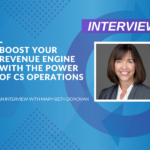Customer success leaders are facing retention revenue losses due to the current global economic downturn. You must focus on maximizing the scalability and efficiency of your customer success organization through customer success automation to maintain strong retention rates during these uncertain times.
You need to introduce automation into your customer success strategy to meet the retention revenue demands of your boards. In this article, we’ll cover how you can launch a strong customer success automation program.
Why automate?
A standardized and automated customer journey is more impactful and effective than one dependent on intervention and prone to human error. Marketing and sales leaders have recognized the value of automation for decades and have prioritized automation initiatives. It’s time to put customer success automation at the top of your priority list.
Automating your customer success processes will help you achieve two critical goals:
- Drive scale: ensure every customer, regardless of contract value, receives the support they need to adopt your solutions.
- Drive efficiency: provide standardized and quicker customer success at a lower cost.
“Transitioning to an automated approach requires significant time and capital investment. It’s important to determine whether automation is right for your company,” suggests this article by Entrepreneur.
Shifting to an automated approach can transform your customer success organization by reducing the time customer success managers (CSMs) spend on administrative work, increasing efficiency, enabling CSMs to dedicate more time to consultations with their customers and ultimately increasing retention rates.
Launching a customer success automation program
Processes, data and technology are the three core components to a customer success automation program. You should prioritize them in that order.
- Processes
Customer success strategy is grounded in process. It’s important to examine your existing customer success processes and understand whether you can improve them prior to introducing automation. If you automate inefficient processes, you may miss an opportunity to improve customer retention rates.
Conducting an as-is assessment of your existing customer journey and processes is a great first step. The goal of an as-is assessment is to determine whether there is significant variation in how your CSMs support their customers. This variation can be further exacerbated by a lack of integration with other customer-facing processes including sales, professional services and support.
Remember that before investing in customer success automation, you must standardize, integrate and optimize the design of the customer success processes you want to automate.
- Data
If processes are the foundation of a customer success strategy, then data is the glues that binds it together. Data triggers the automation of an organization’s customer success processes.
Every technology company’s data is a disaster to one degree or another. Don’t strive for perfection; focus on cleaning up your most important data.
An important data point will trigger an automated touchpoint in a customer success workflow. You can easily identify important data points once you have finalized the workflows you want to automate.
In addition to defining the important data triggers, you must quantify the goals you’re looking to achieve through the automation initiative. For example, you can measure the CSM efficiency gained, or the spike in retention rates gained, through the introduction of automation.
- Technology
Processes are the foundation, data is the glue and technology is the tool that operationalizes the strategy.
After finalizing your workflows and confirming your data triggers, turn your attention to ‘how’ and determine which tool will automate your processes.
Many technology companies purchase a customer success tool to operationalize and automate their customer success processes. A customer success tool centralizes all processes and data in a single platform. This centralization has the potential to lead to additional increases in efficiency and retention rates. There are many customer success tools on the market that differ in robustness, complexity and price.
Other customer success leaders leverage existing infrastructure, such as customer relationship management (CRM) software, to automate their workflows. A CRM can automate intertwined processes managed by different teams. It is also more cost-effective than purchasing new software.
Plan for success
You need to establish a project plan for the development work in addition to selecting a tool to operationalize your strategy. We recommend starting small and focusing on a segment of your customer success processes.
At Valuize, we employ an agile methodology in our projects by introducing automation to the most critical processes first, then expanding from there. This approach enables you to develop a project framework so you can easily expand your automation project and achieve your long-term retention goals.
The subscription economy may continue to struggle for the foreseeable future. You must act now or you risk losing additional retention revenue. Start examining your customer success processes, data and technology, and commit to an automation transformation.
Realize your customer success automation goals
What goals do you want your customer success organization to achieve, and how can the introduction of automation help you reach those goals? Contact Valuize to explore ideas.






